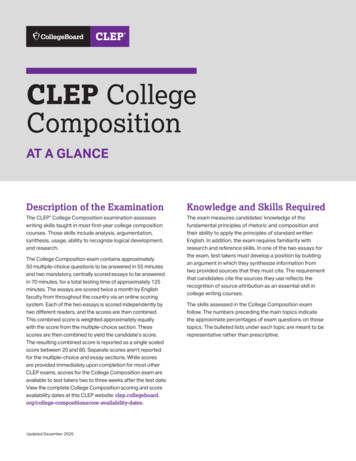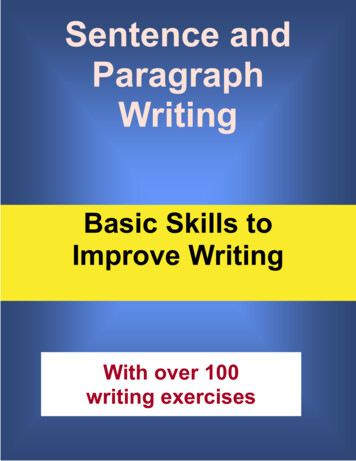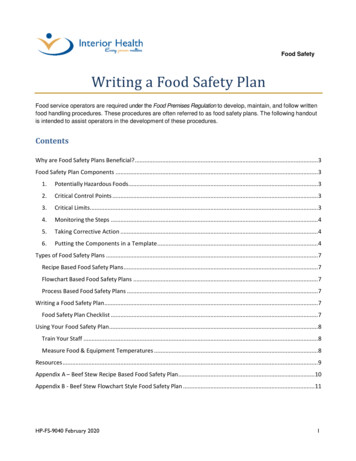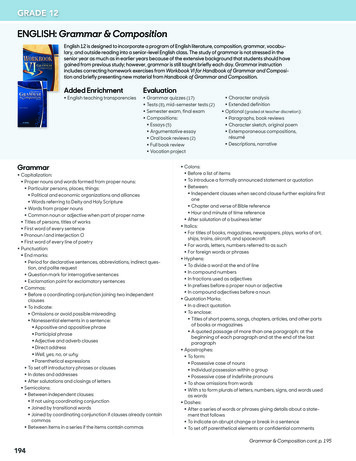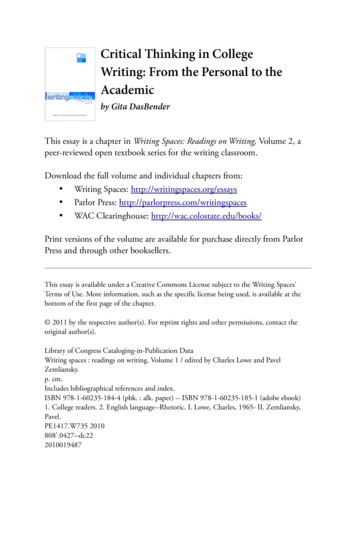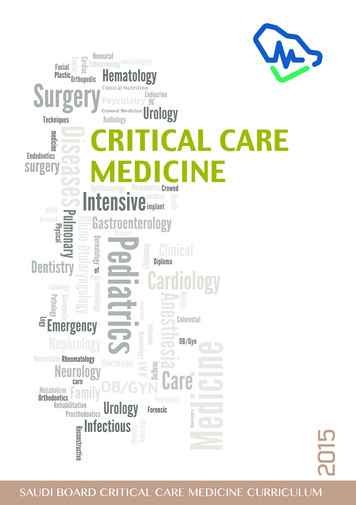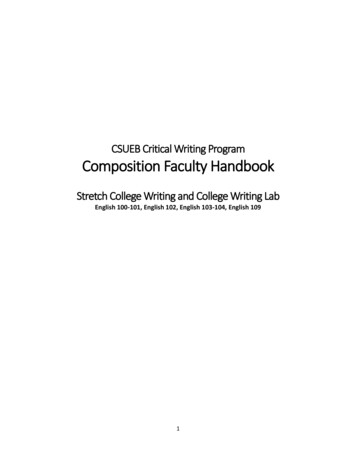
Transcription
CSUEB Critical Writing ProgramComposition Faculty HandbookStretch College Writing and College Writing LabEnglish 100-101, English 102, English 103-104, English 1091
CSUEB Composition Program HandbookTable of ContentsLower Division Composition Placement .page 4o California State University System-Wide Placemento CSUEB Directed Self Placemento Composition I Overview Institutional and Program Positions on Writing page 6o CSUEB Institutional Learning Outcomes (ILOs) for Written Communicationo CSUEB ILOs Written Communication Rubrico CSUEB General Education Rubric for Written Communicationo CSUEB Composition Program Statement on Thinking, Reading, and Writing Composition I: English 100/101 (Stretch), English 102 (Accelerated), English 103/104(Stretch ESOL) .page 13o Composition I: English 100, College Writing Stretch I .page 13 Course Catalog Description General Course Information Course Objectives Course Learning Outcomes Course Benchmarks Course Requirements Suggested Essay Sequencing for English 100 Supplemental Writing Assignments Supplemental Materials Suggested Textbooks and Nonfiction Textso Composition I: English 101, College Writing Stretch II page 15 Course Catalog Description General Course Information Course Objectives Course Learning Outcomes Course Benchmarks Course Requirements Suggested Essay Sequencing for English 101 Supplemental Writing Assignments Portfolio Assignment Supplemental Materials Suggested Textbooks and Nonfiction Textso Composition I: English 102, Accelerated College Writing .page 19 Course Catalog Description General Course Information Course Objectives2
Course Learning OutcomesCourse BenchmarksCourse Requirements Suggested Essay Sequencing for English 102 Supplemental Writing Assignments Portfolio Assignment Supplemental Materials Suggested Textbooks and Nonfiction Textso Composition I: English 103, College Writing Stretch I (ESOL) .page 23 Course Catalog Description General Course Information Course Objectives Course Learning Outcomes Course Benchmarks Course Requirements Suggested Essay Sequencing for English 103 Supplemental Writing Assignments Portfolio Assignment Supplemental Materials Suggested Textbooks and Nonfiction Textso Composition I: English 104, College Writing Stretch II (ESOL) page 25 Course Catalog Description General Course Information Course Objectives Course Learning Outcomes Course Benchmarks Course Requirements Suggested Essay Sequencing for English 104 Supplemental Writing Assignments Portfolio Assignment Supplemental Materials Suggested Textbooks and Nonfiction Textso Composition I: English 109 College Writing Lab .page 30 Course Catalog Description General Course Information Student Learning Outcomes Overarching Teaching Guidelines SCAA Writing Associates (WA) Appendix A: Sample Assignments and Class Activities .page 32 Appendix B: Textbooks and Nonfiction Texts .page 453
Placement and Composition I OverviewCalifornia State University System-Wide PlacementAs of fall 2018, the California State University system will eliminate the English Placement Test(EPT) and rely on “multiple measures” to identify students’ preparation for college writing.These measures include high school GPA, standardized test scores (SAT, ACT, and Californiamandated assessments), and other factors associated with high school success. Based on thealgorithm developed by the Chancellor’s Office, students will be placed in one of the fourfollowing categories: Category I— identifies students who have earned college credit for GE area A2 throughexam (such as the AP test) or transfer credit. These students do not enroll in anyComposition I course. Category II— identifies students who are deemed “ready.” These students are advisedto enroll in Comp I: ENGL 102, Accelerated Composition (Accelerated). They maychoose to take English 109, a one-unit tutorial lab. Category III—identifies students who are “ready” but may need “enhanced instructionduring the regular school year.” These students must complete Comp I: ENGL 100/101Stretch Composition (Stretch) or ENGL 102 Accelerated with concurrent enrollment inENGL 109. Category IV— identifies students who are “ready” but are likely to struggle with collegewriting. These students are required to complete Comp I: ENGL 100/101 Stretch orComp I: ENGL 103/104 ESOL Stretch with concurrent enrollment in ENGL 109. Theymay also be required to participate in the Early Start program.CSUEB Directed Self-Placement for Category III StudentsSeveral CSU writing programs use Directed Self-Placement (DSP) to help students choose thewriting course that best meets their need. Although many CSU campuses use DSP for allstudents, our campus will use DSP for students in Category III, those most likely to benefit fromconsidering their writing placement beyond their multiple-measures classification.Students in Category III will have the option of completing 4 units in Comp I: ENGL 102Accelerated with concurrent enrollment in ENGL 109 or completing 6 units over two-semestersin Comp I: ENGL 100/101 Stretch. Students in Category III who choose the stretch sequencehave the option of taking ENGL 109 though it is not required.Below is the CSUEB’s DSP assessment procedure for Category III students:4
College Writing Pathways for Category IIIWelcome to Cal State East Bay’s Critical Writing Program! If you received a CategoryIII placement for English composition, you have two options for meeting the generaleducation requirement in written communication. This handout will help you decidewhich option is better for you. Please read about your two options and answer thequestions below.RECOMMENDED STRETCH OPTION: Stretch College Writing I & II (6 units total)The stretch option requires two classes, English 100 in fall and English 101 in spring. This optionbegins with shorter reading and writing assignments and builds towards longer, morechallenging ones. It also gives you a chance to make strong personal and academic connectionswith your classmates and your instructor because you will stay together for the whole academicyear.ACCELERATED OPTION: Accelerated College Writing Writing Lab (4 units total)The accelerated option requires two classes, English 102 and English 109. These two classes aretaken during the same semester. The accelerated option begins with 5-7 page essays and longerreading assignments, so the pace and initial expectations for this option are more intense thanthe stretch option.QUESTIONS: If you answer yes to all or most of the questions below, the accelerated option islikely a good choice for you. If you answer no, not all the time, or not sure to most of thequestions, the stretch option is the better choice.Reading Do you read a lot for pleasure and for school? Are you confident about your ability to understand and analyze difficult texts? Would you be comfortable reading 30-40 pages of dense text every week?Writing Do you enjoy writing for different audiences and purposes? Would you describe yourself as a strong academic writer? Do you have experience writing 5-7 page papers every 2-3 weeks?Habits of Mind Do you take an active role in your own learning? Are you a curious person who enjoys exploring different aspects of an issue orproblem? Would you describe yourself as a person who is persistent when faced with achallenging assignment?Still unsure about which writing pathway is better for you? Please email us to set up an in-person,phone, or Skype advising appointment.Coordinator of Composition: Dr. Margaret Rustick margaret.rustick@csueastbay.eduEnglish Department Chair: Dr. Sarah Nielsen sarah.nielsen@csueastbay.edu5
Composition I OverviewComposition I courses introduce students to writing in the university with a special awareness ofthe challenges freshmen face when making the transition from high school to college. In additionto comprehending and producing written language at an advanced level, freshmen need to learnhow to participate in academic culture with its often unspoken rules and expectations. Comp Ibegins the process of helping students read, write, and think like academics.Composition I courses at CSUEB are English 100/101, English 102, English 103/104. Studentswho complete Composition I according to their placement with a grade of C- or higher havesatisfied their GE, A2 requirement. Therefore, regardless of course placement, students willmeet the same learning outcomes in all Comp I courses.CSUEB Institutional Learning Outcomes (ILOs) for Written CommunicationAlthough the ILOs in written communication are goals for seniors, we must instill these goals inour freshman if they are to reach the outcomes at the end of their senior year.Below is the CSUEB ILOs statement and the written communication rubric that guide ourComposition I courses’ objectives, learning outcomes, and benchmarks:Graduates of Cal State East Bay will be able to communicate ideas, perspectives, andvalues clearly and persuasively while listening openly to others.Developing strong oral, written, and creative communication skills is an importantlearning outcome for our graduates because these skills are fundamental to activeparticipation in a democratic society and to achievement in professional life aftergraduation. Communication implies an exchange between two or more people, socommunication is about expressing one’s own ideas, perspectives, and values as well asunderstanding the ideas, perspectives, and values of others.Strong communication skills include: identifying the audience and purpose for a particular communication situation;representing knowledge orally, visually, and in writing;expressing ideas, perspectives and values clearly and coherently;supporting ideas, perspectives, and values with reasons and evidence;understanding other perspectives on a particular topic;locating, evaluating and using information appropriately;listening actively, empathetically, and respectfully;being open to new ideas and to changing perspectives when presented with newevidence;using various forms of communication and communication technologies.6
CSUEB ILO Written Communication Rubric Approved by Academic Senate, May, 2017Description: Written communication is the development and expression of ideas in writing. Writtencommunication involves learning to work in many genres and styles. It can involve working with manydifferent writing technologies, and mixing texts, data, and images. Written communication abilitiesdevelop through iterative experiences across the curriculum.4321Statement of purpose,thesis or controlling idea(s)Clearly states a central idea,appropriate to theassignment.Adequately states a centralidea, generally appropriateto the assignment.Inconsistently orsuperficially states a centralidea, minimally appropriateto the assignment.Lacks statement of a centralidea, or states central ideainappropriate to theassignment.Audience awarenessDemonstrates clearunderstanding of audience,appropriate to theassignment.Demonstrates adequateunderstanding of audience,generally appropriate to theassignment.Demonstrates inconsistentor superficial understandingof audience, minimallyappropriate to theassignment.Lacks an understanding ofaudience.Organization, cohesion,and clarityClearly structured aroundthe central idea. Uses arange of transitions toconnect ideas, and is easy tofollow.Adequately structuredaround the central idea. Usessome transitions to connectideas, and is generally easyto follow.Has minimal structurearound the central idea. Usesfew transitions to connectideas, and is somewhatdifficult to follow.Lacks structure around thecentral idea. Lackstransitions that connectideas, and is difficult tofollow.Presentation of supportingideasPresents evidence and ideasthat clearly support anddevelop the central idea.Presents evidence and ideasthat generally support anddevelop the central idea.Presents evidence and ideasthat minimally support anddevelop the central idea.Does not present evidence orideas that support or developthe central idea.Language usage, sentencestructureUses sophisticated andvaried sentence structures.Demonstrates appropriatelanguage choices.Shows correct use ofgrammar, spelling, andpunctuation.Uses little variation insentence structure.Minimally demonstratesappropriate languagechoices.Contains grammar, spelling,and punctuation errors thatare distracting oroccasionally interfere withmeaning.Lacks variation in sentencestructure. Does notdemonstrate appropriatelanguage choices.Mechanics: grammar,punctuation, and spellingUses some variation insentence structure.Generally demonstratesappropriate languagechoices.Shows mostly correct use ofgrammar, spelling, andpunctuation. May haveoccasional errors that do notinterfere with meaning.7Contains grammar, spelling,and punctuation errors thatare highly distracting oroften interfere withmeaning.
CSUEB General Education Rubric for Written Communication (GE A2 Requirement)The following GE A2 Written Communication rubric is a draft based on the learning outcomesdescribed in CSU Executive Order 1100. The purpose of the rubric is to give the GE andEnglish departments data points for measuring the effectiveness of this program.CSUEB General Education Written Communication, First-year Composition (GE Area A2) Rubric Draft 5-25-18Developed by English department faculty for pilot in 2018-19 academic year.4Attitude andapproach tolearningReflection onstudents’ ownworkdemonstrateshabits of mindassociated withsuccessful firstyear collegereading, writing,and thinking 321Consistently Generally demonstrates Somewhat Demonstrates limiteddemonstratesawareness of one’s owndemonstratesawareness of one’sawareness oflearning, intellectualawareness of one’sown learning,one’s ownevolution, ongoingown learning,intellectual evolution,learning,challenges as anintellectual evolution,ongoing challenges asintellectualacademic reader,ongoing challenges asan academic reader,evolution,writer, thinker.an academic reader,writer, thinker.ongoing Exhibits generalwriter, thinker. Exhibits lowchallenges as anconfidence and Exhibits someconfidence andacademic reader,persistence in readingconfidence andpersistence inwriter, thinker.complex texts andpersistence in readingreading complexExhibitswriting successfulcomplex texts andtexts and writingconfidence andpapers for a variety ofwriting successfulsuccessful papers forpersistence inrhetorical situations.papers for a variety ofa variety of rhetoricalreading complex Often explores issues,rhetorical situations.situations.texts and writingquestions, and other Sometimes explores Rarely exploressuccessful papersintellectual endeavors.issues, questions, andissues, questions, andfor a variety of Illustrates acceptanceother intellectualother intellectualrhetoricalof ambiguity andendeavors.endeavors.situations.acknowledgement of Sometimes illustrates Illustrates little to noClearly exploresissue complexity.acceptance ofacceptance ofissues, questions, Generally demonstratesambiguity andambiguity andand otheruse of the recursiveacknowledgement ofacknowledgement ofintellectualprocess of writing andissue complexity.issue complexity.endeavors.its connection to criticalAptly illustratesreading and thinking.acceptance ofambiguity andacknowledgementof issuecomplexity.8
Rhetoricalknowledge“The ability toanalyze contextsand audiencesand then to acton that analysisincomprehendingand creatingtexts.” (WPAOutcomesStatement, 17July 2014) Consistentlydemonstrates useof the recursiveprocess of writingand its connectionto critical readingand thinking. Clearlydemonstratesawareness ofdifferentperspectives andtexts, movingtoward asophisticatedresponse to them.Illustratesconsistent abilityto develop andmaintain anintended purposefor an identifiedgenre andaudience.Aptly chooseslanguage inservice of arhetoricalsituation. Thoughtfullyorganizes anddevelops writingaround acontrolling idea.Provides logicaland sophisticatedconnectionsamong ideas thathelp to progress acoherent train of Textual/globalqualities ofwriting productsOrganizationanddevelopment Generallydemonstratesawareness ofdifferentperspectives andtexts, moving towarda sophisticatedresponse to them.Often illustratesability to develop andmaintain an intendedpurpose for anidentified genre andaudience.Chooses language inservice of a rhetoricalsituation. Organizes anddevelops writingaround a controllingidea.Provides connectionsamong ideas thathelp to progress atrain of thought.Presents arecognizable voicethat generally meets 9 Demonstrates someawareness ofdifferentperspectives andtexts.Somewhat illustratesability to develop andmaintain an intendedpurpose for anidentified genre andaudience.Chooses languagesometimes in serviceof a rhetoricalsituation. Somewhat organizesand develops writingaround a controllingidea.Sometimes providesconnections amongideas that help toprogress a train ofthought.Inconsistentlypresents a Demonstrates littleawareness ofdifferentperspectives andtexts.Rarely illustratesability to developand maintain anintended purposefor an identifiedgenre andaudience.Chooses languageinappropriate to arhetorical situation.Rarely organizesand developswriting around acontrolling idea.Minimally providesconnections amongideas that may/notprogress a train ofthought.Does not present arecognizable voice
Textual/localfeatures ofwriting productsLanguage, style,voice, bution, andformattingthought.Presents adistinct, crediblevoice that meetsthe demands ofpurpose,audience, andgenre.Exhibits complex,rhetorical movesin response to alargerconversation. the demands ofpurpose, audience,and genre.Exhibits rhetoricalmoves in response toa larger conversation. recognizable voicethat may/not meetthe demands ofpurpose, audience,and genre.Inconsistentlyexhibits rhetoricalmoves in response toa larger conversation. that does not meetthe demands ofpurpose, audience,and genre.Does not exhibitrhetorical moves inresponse to alargerconversation. Uses sophisticated language to craft aclear message withappropriate styleand voice for theaudience, purpose,and genre. Demonstrates sophistication inword choice andvaried sentencestructure. Exhibits carefulediting andproofreading thatenhances writer’scredibility.Uses suitable language to craft a clearmessage withgenerally appropriate,style and voice for theaudience, purpose,and genre.Demonstrates some sophistication in wordchoice and variedsentence structure.Exhibits evidence of editing andproofreading that mayenhance writer’scredibility.Uses somewhat suitable language tocraft a message withsomewhat appropriatestyle and voice for theaudience, purpose,and genre.Demonstrates little sophistication in wordchoice and variedsentence structure.Exhibits little evidence of editing andproofreading that mayenhance writer’scredibility.Uses unsuitablelanguage to craft amessage withinappropriate styleand voice for theaudience, purpose,and genre.Lacks sophisticationin word choice andvaried sentencestructure.Exhibits no evidenceof editing andproofreading. Precisely documents sourcesand consistentlyuses academicconventionsappropriate to rhetorical situation. Choosesappropriatesources andcogently integratesthem in service ofthe writer’s claim.Documents sources and generally usesacademic conventionsappropriate torhetorical situation.Chooses generallyappropriate sources and suitably integratesthem in service of thewriter’s claim.Infrequently documents sourcesand infrequently usesacademic conventionsappropriate torhetorical situation.Chooses somewhatappropriate sourcesand attempts to integrate them inservice of the writer’sclaim.Incorrectlydocuments or doesnot documentsources and doesnot use academicconventionsappropriate torhetorical situation.Choosesinappropriatesources thatinterfere withwriter’s claim.10
As required by the Academic Senate and the GE Subcommittee, GE A2 learning outcomesshould be included in all English 100/101, 102, and English 103/104 syllabi.The current GE A2 written communication learning outcomes are as follows. Write effectively in English for a variety of purposes and audiencesExplain the principles and rhetorical perspectives of effective writing, including its form,content, context and styleAdvocate for a cause or idea, presenting facts and arguments in an organized andaccurate mannerPractice the discovery, critical evaluation, and reporting of information11
CSUEB Composition Program Statement on Thinking, Reading, and WritingThinking Students will build on their experiences in extended, critical engagement with ideasCritical thinking is the foundation of academic cultureFor critical engagement of ideas, instructors need to enhance students’ abilities to be reflective, understanding who and what influences their ideas become “problematizers” who work toward informed opinions analyze and synthesize the ideas of others gain awareness of their own thinking, reading, and writing processesReading Reading is a cross-disciplinary skill all students must use, and all freshmen are expectedto read at the freshman level in all their classes Entering freshmen have limited experience with texts that use audience and purpose todetermine format, such as nonfiction, nonfiction social commentary, or college-leveltextbooks Students will see reading and writing in a broad, social context if they read a variety oftheme-based essays As teachers, we need to enhance students’ abilities to process units of meaning instead of reading word by word summarize, analyze, and evaluate what they read recognize the writer’s assumptions and purpose recognize and become part of the writer’s intended audienceWriting Academic writing takes time, is not based solely on personal experience, and is driven bydiscipline demands, the writer’s purpose, and the audience’s expectationsAcademic writing depends on a writer’s ability to formulate questions, use research forexploration, and analyze and revise ideasAcademic writers use a variety of rhetorical strategies to develop and present ideasOur approach to teaching students how to write for academia should include ways to brainstorm for a topic with various writing-to-learn strategies such as freewriting,outlining, mapping, clustering, researching, etc. analyze a topic from various perspectives devise thoughtful questions that lead to a thesis/claim sustain a thesis/claim throughout an essay organize and develop an essay for an identified audience provide appropriate reasons and evidence for a thesis/claim recognize the difference between revision and editing, and do either or both at theappropriate time12
Composition I: English 100/101 Stretch, English 102 Accelerated, English 103/104Stretch (ESOL)Composition I: English 100, Stretch I Course Catalogue Descriptiono ENGL 100 College Writing: Stretch I (3 units)First semester of year-long course in reading and writing for academic purposes.Mandatory, with concurrent enrollment in ENGL 109, for students who place inCategory IV. Optional for students who place in Category III. Must pass with Cor better to advance to ENGL 101 General Course Informationo English 100 is a three-unit courses (1 unit 50 minutes of contact per week,which means 75-minute sessions for a class that meets twice per week)o Category III students in English 100/101 have the option to take English 109although it is recommended that they take the one-unit writing labo Category IV students in English 100/101 are required to enroll in English 109, aone-unit writing lab.o During the academic year, English 100/101 students will write approximately10,000 words (40 final-draft pages)o During the academic year, English 100/101 students will read approximately 400600 pages of published nonfiction writing, including articles, essays, and at leastone full-length, non-fiction book English 100: Course Objectiveso Recognize that writing is part of a conversationo Learn to read beyond content by examining structure, purpose, and audienceo Demonstrate respect for the thoughts of otherso Demonstrate an ability to understand multiple perspectives in relation to one’sowno Gain and apply rhetorical knowledge to analyze the written and spoken ideas ofotherso Gain and apply rhetorical knowledge to increase reading comprehensiono Gain and apply rhetorical knowledge to improve writing efficacyo Recognize how writers adapt language for various audiences and purposes,especially those common in academic writing taskso Recognize how writers adapt formats for audiences and purposes, especially thosecommon in academic writing taskso Lean to use a variety of strategies to develop ideas and shape written draftso Improve ability to peer review other’s writing by applying learned skillso Produce a thoughtful, carefully edited, 4-6-page academic essay with a clearthesis/claim, transitions, reasons, evidence, and appropriate language English 100: Course Learning Outcomeso Ability to write, revise, and edit short essays in Englisho Ability to understand the difference between opinions and informed opinion13
o Ability to understand how to use, and how others use, rhetorical strategies tosolve problemso Ability to discover, evaluate, and use informationo Ability to advocate for a cause or idea, presenting facts and arguments in anorganized and accurate manner English 100: Course Benchmarkso The following Benchmarks are suggestions for the concepts and skills that shouldbe introduced by certain points in the semester. As the processes of teaching andlearning are not linear, the Benchmarks cannot realistically reflect the progressstudents make throughout the semester. Learning and teaching these skills is arecursive process, so many of these skills will be retaught and continuallyemphasized throughout the term.Week 5 Benchmarks Active ReadingAnnotatingWriting ProcessRhetorical SituationSummaryResponseOrganizationArticulating a claimIntroduction to PeerReview/CollaborationParaphrasingPoint of ViewRevision (essayglobal issues)Editing (principlesof editing & MLAformatting)Regular ReadingPractice, includingannotation.*COMPLETION OF MAJORESSAY 1Week 10 BenchmarkWeek 15 Benchmarks Identifying anauthor’s purpose,audience, andstrategy Inference Distinguishingbetween claim andevidence Analysis(visual/textual) Revision (paragraphunity, coherence) More advancedediting (strategies) Developmentalstrategies Organization Vocab strategies Regular ReadingPractice, includingannotation andanalysis*COMPLETION OF MAJORESSAY 2 ArgumentEthos, pathos, logosToulmin rhetoricPersuasionRevision (movingtoward seeing theconnectionbetweensentence/paragraph/essay style &coherence)More advancedediting information literacyRegular ReadingPractice*COMPLETION OF MAJORESSAY 3 English 100: Course Writing Requirementso Suggested Essay Sequencing for English 10014Week16 Benchmarks Reflective Thinkingand WritingReview of readingand writingconceptsintroducedthroughout thesemesterIntrospection ondevelopment as anacademic readerand writer*COMPLETION OFREFLECTIVE ESSAY
Four Major Essays: Summary/Response Rhetorical Analysis Persuasion Reflectiono Other Writing Assignments of Various Length Prereading assignments Summaries and short analysis Identifications of rhetorical devices Skill building exercises Essay development pieces Revision and editing exercises English 100: Supplemental Materialso See appendix A English 100: Suggested Textbooks and Nonfiction Textso See appendix BComposition I: English 101, Stretch II Course Catalogue Descriptiono ENGL 101 College Writing: Stretch II (3 units)Second semester of year-long course in reading and writing for academicpurposes. Must pass course with C- or better to earn General Education, A2credit. Prerequisite: ENGL 100. General Course Informationo English 101 is a three-unit courses (1 unit 50 minutes of contact per week,which means 75-minute sessions for a class that meets twice per week)o Category III students in English 100/101 have the option to take English 109although it is recommended that they take the one-unit writing labo Category IV students are required to enroll in English 109, a one-unit writing labo Students at the end of both English 101 and English 102 have met a shared set oflearning objectiveso During the academic year, English 100/101 students will write approximately10,000 words (40 final-draft pages)o During the academic year, English 100/101 students will read approximately 400600 pages of published nonfiction writing, including articles, essays, and at leastone full-length, non-fiction booko At the end of the semester, English 101 students will create writing portfolios, tobe evaluated by composition instructors. The portfolio evaluation results will be arecommendation and will not dictate students’ final grades. English 101: Course Objectiveso Recognize that writing is part of a conversationo Learn to read beyond content by examining structure, purpose, and audienceo Demonstrate respect for the thoughts of others15
o Demonstrate an ability to understand multiple perspectives in relation to one’sown ideaso Apply rhetorical knowledge to analyze written and spoken ideas of otherso Apply rhetorical knowledge to increase reading comprehensiono Apply rhetorical knowledge to improve writing efficacyo Recognize how writers adapt language for various audiences and purposes,especially those common in academic writing taskso Recognize how writers adapt formats for audiences and purposes, especially thosecommon in academic writing taskso Use various strategies to develop ideas and shape written draftso Utilize resources, such as feedback and published reference materials, to improveclarity, coherence, and conventional corr
Composition I courses at CSUEB are English 100/101, English 102, English 103/104. Students who complete Composition I according to their placement with a grade of C- or higher have satisfied their GE, A2 requirement. Therefore, regardless of course placement, students will meet the same learning outcomes in all Comp I courses.
